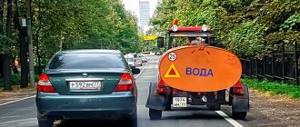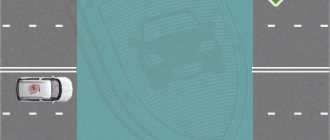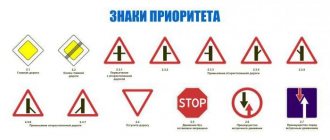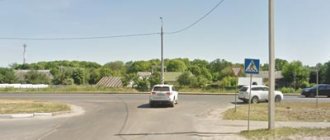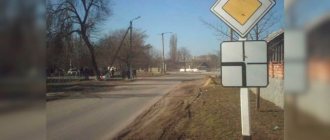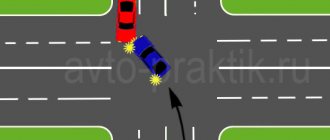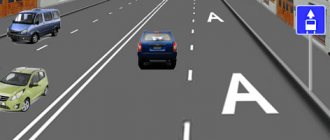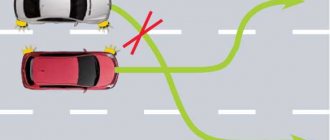Legal advice > Administrative law > Road accidents, traffic police, traffic rules > Main road traffic rules or the main thing you need to know about it
From the first rules created for pioneer motorists to the present day, the main and most used principle for building relationships between drivers on the road is the principle of priority.
It is this principle that is embedded in the logic of constructing many formal rules governing traffic at street intersections, the order and necessity of installing road signs and applying road markings, which of the traffic participants has a priority right to pass through the intersection largely determines the safety of all traffic participants. That is why the concept of “main road” in the traffic rules and everything connected with it was and is the basic principles of traffic organization, affecting all traffic participants without exception.
What is a main road - definition, terms and basic concepts
This is what the “Main Road” sign looks like
The concept of “main road”, according to the Road Traffic Rules, is interpreted as a road marked with appropriate signs and having a hard surface, if this applies to the situation when one of the roads at the intersection is asphalted or has another hard surface, and the other is unpaved.
In this definition, there are objectively several points that deserve special attention:
- The definition speaks of a mandatory road crossing or crossroads;
- The road must be marked with road signs indicating that the driver located on this section of the road has the right of priority passage through the intersection, at the same time, other drivers and pedestrians are required to give way to the intersection;
- That the definition of a main road includes areas adjacent to exits from parking lots, parking lots and technical areas of enterprises.
- In the absence of signs and indicators, at the junction of the dirt road and the paved road, this area is the entrance to the main road, and the small asphalt area in front of the exit cannot be considered a section of the paved road.
How to determine the main road by signs and without them
Hello, friends! Today we are talking about what is the main road at the crossroads.
Situations vary. In most cases, intersections are equipped with the necessary signs and indicators. Based on them, you can answer the question posed, and then make the right maneuver.
But it also happens that there are no signs. And in such a situation it is not entirely clear how to look at the main road.
To simplify the task, we will consider several situations and try to answer pressing questions.
Road signs: what they look like and what they mean
To designate a main road, most countries use a sign in the form of a regular diamond with 90-degree angles, white, with a yellow or sometimes orange border around the perimeter. In some countries, an additional letter qualifier is used, corresponding to the term "Main Road". The installation of this sign is usually applied directly to the road to which the priority position is assigned.
To mark adjacent roads, signs are used in the form of white equilateral triangles, with a red border around the perimeter, with an image of the road situation in the center. They are installed on the main road to inform drivers about possible situations for making the desired maneuver.
On adjacent roads, depending on local conditions, “STOP” or “Give way” signs are installed. They are installed immediately before an intersection or before entering the road.
The “Highway” sign can also be used for marking on highways and roads of national importance.
Sign installation and coverage area
The sign is valid from the place where it is installed until the next sign indicating the termination of the coverage area.
Almost always, the “main road” sign is installed and regulates the priority of traffic for a separate section or the entire road from the installation site to the place where the sign that terminates its effect is installed, that is, to the installed “end of the main road” sign.
Such a sign in front of the intersection clearly states the priority in passing the intersection, but even in this case, its coverage area extends to the road. Outside the populated area, sections of the main road are marked in the same way.
A road sign indicating the main road must be installed at the beginning of the section and extends its effect to the entire section of the road, including intersections.
Signs informing about the junction or intersection of secondary roads can be installed in front of intersections both with “main road” signs, and independently, in the case where a dirt road adjoins. On international highways and national highways, signs are installed at the beginning of the highway section.
KarpOff-270 › Blog › Topic 1. General provisions. Part 3
The main road.
Give way (do not interfere). Advantage (priority). Not only do roads intersect at an intersection; conflicting traffic flows intersect at an intersection. If this is a controlled intersection, the traffic order is determined by the signals of the traffic light or traffic controller. If this is an uncontrolled intersection, the traffic order is determined by the status of the road.
Rules. Section 1. “Main road” - a road marked with signs 2.1, 2.3.1 - 2.3.7 or 5.1 in relation to the one being crossed (adjacent), or a road with a hard surface (asphalt and cement concrete, stone materials, etc.) in relation to to a dirt road, or any road in relation to exits from adjacent territories. The presence of a paved section on a minor road immediately before the intersection does not make it equal in importance to the one it intersects.
If the road has been designated as the main one, then along its entire length in the populated area there will be signs 2.1 in front of each intersection.
As for intersections outside a populated area, here, in addition to sign 2.1, the Rules considered it necessary to introduce a whole series of special signs to indicate the main road.
These signs not only inform the driver that he is moving on the main road, but also tell him the shape of the intersection that he will soon pass. A detailed discussion about these signs is ahead, but for now just look at them and agree that they are very expressive and absolutely understandable.
Finally, there is another sign giving the road the status of a main road. This is sign 5.1 "Motorway". We will also talk in detail about this sign and in general about the procedure for driving on highways in the future, but for now we will just note: The highway is always the main road!
In addition to this, the Rules define two more situations when the road can be the main one without any signs. A). The main road is a road with any hard surface in relation to the dirt road.
Any hard surface is asphalt, concrete, paving stones, and even gravel. If the road is simply “rolled” along the ground, it is a dirt road. If two roads with different hard surfaces intersect and there are no priority signs, this is an intersection of equivalent roads.
When leaving the yard, parking area, gas station, etc., we always find ourselves on the main road.
Give way. Do not cause interference.
In the text of the Rules you will find both terms. In one place of the Rules you will read: “Drivers must give way, etc.” Elsewhere in the Rules you will read: “Drivers must not cause interference, etc.” Both terms mean the same thing. But unfortunately, not every driver understands correctly what exactly they mean. Let's try to understand these terms using specific examples.
It is quite possible that you have a question: “Why should you give in to someone on the right and not on the left?” This requirement of the Rules is nothing more than a consequence of right-hand traffic adopted in our country. Agree that your distance to the point of collision is greater than that of the driver of the gray car, that is, it is easier for you to comply with the “Give way” requirement. Tell me, will you now give way to a gray car? He's still on your right!
Most likely, you will now pass through the intersection first. But!
Before driving, did you estimate the distance to the gray car? Before passing, did you estimate the speed of the gray car? Before driving, you took into account the condition of the road surface (if there is ice, then you can skid at the intersection). Before driving, you remembered the level of your driving skill (if you start off ineptly, the engine may stall). Before driving, you took into account the dynamic capabilities of your “iron horse” (how sensitively it reacts to the accelerator pedal).
You understood that all responsibility for the safety of travel lies entirely with you! You could make another decision - stop and (to be safe) let the “gray” pass. But in both cases (you passed first or second) you did this, giving way to the driver of a gray car
!
To summarize:
“Give way” is a requirement that does not mean a mandatory stop!
It is obligatory not to create any interference with those who have an advantage over you in movement. “Impair” means forcing another driver to change speed or direction. The fact that the driver passed first (without causing interference) does not mean that he did not give way. The rules define the term “give way” as follows:
Rules. Section 1. “Give way (do not interfere)” is a requirement that means that a road user must not start, resume or continue moving, or carry out any maneuver if this may force other road users who have priority over him , change direction or speed.
And again, it must be said that in the text of the Rules you will find both terms. Somewhere it will be written: “The driver has priority, etc.” Somewhere it will be written: “Priority of route vehicles.” Both of these terms mean the same thing, namely, the right to priority movement in the intended direction.
“Advantage (priority)” and “Give way (do not interfere)” are interrelated terms: if one already has an advantage, then the other must give way. It is only important that in any situation all road users accurately determine their status: who you are now - “first” or “second”.
The rules define the term “advantage” as follows:
Rules. Section 1. “Advantage (priority)” - the right to priority movement in the intended direction in relation to other road users.
Overtaking and getting ahead.
Overtaking is the most difficult and most dangerous maneuver. It is not for nothing that the Rules devoted a separate section to it and introduced a whole list of restrictions on the performance of this maneuver. Here it is only important that the driver clearly understands what overtaking is and how it differs from ahead.
Overtaking always means going into oncoming traffic!
This means that overtaking, as the Rules interpret it, is possible only in the following three cases.
1. Or it is a two-lane road with intermittent center lines.
Source: www.drive2.ru
Signage on minor roads
In a situation where a main road intersects a minor road or a minor road adjoins a main road, priority signs must be installed requiring you to give way to vehicles traveling on the main road. “STOP” or “Give Way” signs in front of the intersection being crossed are duplicated by corresponding markings in the form of a “stop line”.
When a traffic light is installed, all traffic participants must be guided by the traffic light signals, and if it is turned off or switched to a flashing yellow light mode, by the installed road signs.
How to identify a main road without a sign
The basic rule for a driver in an area without road signs and traffic lights should be the understanding that safety and priority of passage in such a situation can be regulated with the help of other rules.
In this case, any driver must consider himself to be on a secondary road and thus take all measures to allow a car passing on the intersected road to pass. In this case, when approaching an intersection, you need to slow down in advance, stop, assess the situation, and only then continue driving.
Crossroads without signs
Unsigned intersections are not very common on roads. Nevertheless, the driver must be able to navigate them.
Let us turn to paragraph 1.2 of the traffic rules:
“Main road” – a road marked with signs 2.1, 2.3.1 – 2.3.7 or 5.1, in relation to the one being crossed (adjacent), or a road with a hard surface (asphalt and cement concrete, stone materials, etc.) in relation to the dirt road , or any road in relation to exits from adjacent territories. The presence of a paved section on a minor road immediately before the intersection does not make it equal in importance to the one it intersects.
To determine the type of intersection without signs, you need to understand what type of surface each road has.
1. If the coverage is the same, then the intersection is equivalent.
The situation when the driver cannot determine the type of coverage deserves special attention. For example, it’s dark outside, it’s raining, or there’s snow on the roads. In this case, you need to be guided by paragraph 13.13 of the traffic rules:
13.13. If the driver cannot determine the presence of surface on the road (darkness, mud, snow, etc.), and there are no priority signs, he should assume that he is on a secondary road.
This article discusses the rules associated with determining the type of intersection. Well, in the next one we will talk about the rules at an intersection with a traffic controller.
Situation: unregulated intersection of a four-lane road and a two-lane road. Both are asphalt. There are no signs. Is there a main road among these two or are they both equivalent?
. This topic contains comments related to the article.
Situation: unregulated intersection of a four-lane road and a two-lane road. Both are asphalt. There are no signs. Is there a main road among these two or are they both equivalent?
Are there no signs in all directions, or only from your exit? How did you determine that this is an intersection and not an exit from the adjacent territory (as an example)?
It is better to post a diagram of this intersection or a link to a map.
In your case, all answers will be recommendations. I advise you to contact a car lawyer (preferably a lawyer). The fact is, each region (city) has its own unspoken rules. There is judicial practice, there are smart lawyers, there are outsiders, and there are both in one person.
Unfortunately, the navigator does not yet have any legal force. This is just navigation that recommends, but does not bear any responsibility for its readings. Like advertising, buy it, and then you’ll find out what you bought.
How can this be, since they are a supervisory body that gives instructions to road workers? Road workers are attacking traffic cops.
Your doubts are obvious. And the “road workers” and the “supervisory authority” and the traffic police are one and the same person. Those. it is the traffic police that should give all the answers to your problems.
Thanks for the answer. And another question. Yesterday I received a call on my cell phone: they introduced themselves as the insurance company where our car was registered. They asked whether the car had been in an accident, whether we had repaired it or not, and whether it was possible to come take a photo of it? To which I replied: the car was in an accident, I was found guilty, which means I am not entitled to insurance, why take photographs? Answer: that's how it's supposed to be. It’s not clear: the accident took place on May 23, why the call to my cell phone, because my husband’s insurance and our guilt have been proven to date (there was no talk about the trial). What it is? Should I be allowed to take photographs of a salvage vehicle?
Thanks for the answer. And another question. Yesterday I received a call on my cell phone: they introduced themselves as the insurance company where our car was registered. They asked whether the car had been in an accident, whether we had repaired it or not, and whether it was possible to come take a photo of it? To which I replied: the car was in an accident, I was found guilty, which means I am not entitled to insurance, why take photographs? Answer: that's how it's supposed to be. It’s not clear: the accident took place on May 23, why the call to my cell phone, because my husband’s insurance and our guilt have been proven to date (there was no talk about the trial). What it is? Should I be allowed to take photographs of a salvage vehicle?
I suspect they need the photo to reduce their insurance losses. Apparently, the other side wrote too much (from the insurance point of view), and the insurance company wants to make sure that what the victims wrote is not fake.
About sign 2.2. According to GOST, sign 2.2 without the “Give way” sign means that you must follow the right-hand rule. The traffic rules say nothing about this. This sign only confuses at intersections; it is enough to install sign 1.6 “Intersection of equivalent roads.”
About sign 2.2. According to GOST, sign 2.2 without the “Give way” sign means that you must follow the right-hand rule. The traffic rules say nothing about this. This sign only confuses at intersections; it is enough to install sign 1.6 “Intersection of equivalent roads.”
No, not enough. Sign 2.1 is canceled only by sign 2.2. And according to the meaning, it turns out that without the sign 2.4 or 2.5, sign 2.2 speaks of the intersection of equivalent roads.
Thank you. Best regards, Alexandra.
Alexandra , send photos of the scene of the traffic accident, or a link to its panorama. It is impossible to understand from a verbal description what the roads you indicated are.
In August 2013, I got into an accident at an intersection. I still can’t calm down. “Lucky” with a representative. It’s a pity I didn’t read your advice about a lawyer at that moment. The court decision found me guilty, completely, clause 13.11.
Changing direction on a section of road with priority traffic
On sections of roads where the main road changes direction, signs must be installed indicating the order of movement and the change in route. In the classic layout of such a section, on the side of the roadway where there is priority, a “main road” sign is installed, along with an additional information sign “change in direction of travel.”
On the opposite side, where there is no priority, signs are installed indicating that on this section there is priority for oncoming traffic; the signs are necessarily duplicated by road markings.
In urban environments, in such areas, in addition to signs, traffic lights are also installed to ensure safe traffic.
How to act correctly in traffic situations as a driver
Make maneuvers in accordance with the rules of the road!
It is important for the driver to correctly navigate the intersection of the main road and the secondary road and, in strict compliance with traffic rules, make a maneuver; according to the conditions of priority, the following, largely standard situations may most often arise:
- Exit from the secondary road to the main one. When approaching the intersection of a secondary road and the main road, the driver on the secondary road must slow down, and if there is a “STOP” sign or road marking, the “stop line” will come to a complete stop, stopping movement, to allow vehicles and pedestrians to pass along the main road. A “give way” sign before an intersection does not require the vehicle to come to a complete stop, but a complete stop will actually improve road safety.
- U-turn. A U-turn on the main road is permitted in the absence of a double continuous dividing line and several lanes within the intersection, provided that the maneuver will not create a risk of an accident or interference with other road users. On highways and roads with several lanes, turning around is usually permitted at breaks in the dividing line on specially designated sections of the road with signs and road markings.
- Main road and traffic light. The traffic light installed at the intersection requires strict adherence to its signals, therefore, during prohibitory and warning traffic lights, even movement on the main road is prohibited. This rule also applies to traffic lights installed outside populated areas in front of pedestrian crossings. Here the traffic light has priority.
- Ring. On a section with a roundabout, everything depends on how the order of passage of the section is determined; in the case where the roundabout is recognized as the main one, then when approaching it it is necessary to stop to allow traffic to pass around the circle. This is the main rule in roundabouts in many European countries. And in the case when the main road mode is not established on the ring, its passage is carried out on a general basis according to the rules for driving through the intersection of equivalent roads.
- Overtaking. When overtaking, the rules established for this maneuver are observed. You cannot overtake cars crossing a double solid line, and you cannot maneuver at an intersection.
Rules for driving through unregulated intersections
Casper:
05/20/2019 at 06:18
ok... let's start from the beginning.
You are trying everywhere you can and cannot pull the plug on “interference from the right”, although what can be called that in common parlance is called “vehicle approaching from the right” in the traffic rules. Further from the header of the article, where a vehicle moving from the ONWARD direction has suddenly become “interference from the right” when turning left. How? In the traffic rules there is not a word about “from the right” in paragraph 13.12. sometimes they try to justify such a formulation with something like: “substitute the starboard side”, “it will be on the right” and similar nonsense. Maybe it will turn out, maybe not. It may set you up, or it may ram another vehicle into the left side or head-on. why then not “interference in front”? You can get hit in the rear while turning - let’s call this case “interference from behind” then. These are all fantasies with many options for the development of events and there can be no “interference from the right here.” Many times I heard from teachers phrases like: “let these morons at least remember this. let them have an obstacle on the right wherever they can think of,” but focusing on morons and teaching everyone according to the principle “for morons” is not acceptable when there are traffic rules. albeit full of holes.
Very little attention is paid to the concept of “turn” in traffic regulations. there is not even a definition for it. It has nothing to do with the rules for driving through intersections (in fact, driving through an intersection does not occur) and is spelled out in another section (8 - MANEUVERING). priorities when turning are determined only OUTSIDE the intersection by paragraph 8.8. In fact, this is a HOLE in the traffic rules. one of them. To eliminate it, it is enough to simply add a paragraph to section No. 8 with the wording “when turning at an uncontrolled intersection, the driver of the vehicle is obliged to give way to vehicles approaching on an equivalent road.” While this is not the case, one can only be guided by common sense, which is fully consistent with this formulation. but certainly not an “interference to the right” from a vehicle located at the entrance to the intersection on the LEFT.
Next: why do you begin to determine the priority of the vehicle during the process (at completion) of the turn maneuver? The priority of passing through an intersection is determined BEFORE entering it. This is also not written down anywhere, but this is a fact. During any maneuver, the position of the vehicle on the roadway changes and it is no longer possible to determine priorities. This is not possible during maneuvers and for the reason that at the intersection itself, the main/secondary (if there are any) form a INTERSECTION of roadways and essentially cease to be separated - it is impossible to determine the priority of a vehicle already at the intersection because It’s unknown where it got there from—what road it came from. what signs you passed (if any).
Total: the priority of passing an intersection can only be determined BEFORE entering it and then it cannot change, but not in the process of passing it.
Answer
Responsibility for violating the rules
The range of violations related to violation of the rules for driving on the main road and the rules for driving through intersections, punishable by the Administrative Code, is quite large, including violation of maneuvering rules, violation of marking rules, and failure to comply with the rules for passing certain signs.
Basically, for the cases considered in violations, there are violations related to driving through an intersection without stopping and failure to comply with traffic lights.
These violations are punishable by:
- a fine of 800 rubles (in the case of a “stop line”);
- a fine of 1,000 rubles and up to deprivation of rights for 6 months in case of violation of the passage of an intersection equipped with a traffic light.
